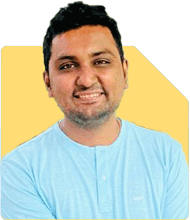Ramalingam Kalirajan |10872 Answers |Ask -Follow
Mutual Funds, Financial Planning Expert - Answered on Jun 26, 2025
He has an MBA in finance from the University of Madras and is a certified financial planner.
He is the director and chief financial planner at Holistic Investment, a Chennai-based firm that offers financial planning and wealth management advice.... more

Sir, I will be retiring from railway service on 31.08.2025. Expected pension will be around 50000/- pm and I may get Rs.5500000/- (fifty five lacs) as final settlement dues including Provident Fund. I live in my own house and have two children aged 23 each who are pursuing various competitive exams after completion of Masters Degree. I need about 60000/-( including medical expense) monthly towards my expenditure. Please provide me a suitable plan to live at peace post retirement.
Monthly Income vs. Expenses After Retirement
Your pension will be Rs. 50,000 monthly.
Your estimated expenses are Rs. 60,000 monthly.
So, you will have a monthly gap of Rs. 10,000.
You will need to generate Rs. 10,000 monthly from your retirement corpus.
Rs. 55 lakh is a strong base to build from.
But the key is how you manage and grow it.
Let us now build the right structure.
Create a Safety Reserve First
First, protect your peace of mind.
You must create a buffer for emergencies.
This should cover at least 12 months of expenses.
That means Rs. 7–8 lakh in low-risk instruments.
Where to keep it:
Fixed deposit
Liquid mutual fund
Bank savings account with auto sweep
This money should be untouched unless there is emergency.
Don’t invest this in long-term plans.
This reserve gives confidence and calmness in tough times.
Divide Your Retirement Corpus into 3 Buckets
You have Rs. 55 lakh in hand.
To use it wisely, divide it into 3 parts.
Each bucket will serve a different purpose.
1. Short-Term Bucket (0–3 years)
Amount: Rs. 12 lakh
Purpose: Cover monthly income gap
Instruments: Hybrid mutual fund, ultra short debt fund
Withdraw Rs. 10,000 monthly through SWP
This bucket gives monthly income stability.
It avoids panic during market falls.
2. Medium-Term Bucket (3–7 years)
Amount: Rs. 15 lakh
Purpose: Support your income after 3 years
Instruments: Balanced advantage funds, conservative hybrid funds
Invest lump sum or STP over 6 months
These funds balance growth and protection.
3. Long-Term Bucket (7+ years)
Amount: Rs. 25 lakh
Purpose: Future inflation protection, legacy for children
Instruments: Flexi-cap mutual funds, large and mid-cap funds
Invest via STP over 12–24 months from liquid fund
This is your growth engine.
It helps you beat inflation over next 15–20 years.
Ensure SIPs or SWPs Are in Regular Mutual Funds
Do not invest in direct mutual funds.
Why direct funds are risky:
No guidance
No portfolio review
Wrong scheme selection
You may miss changes in fund quality
No behavioural support during market fall
Use only regular mutual funds.
Invest through a Mutual Fund Distributor backed by a Certified Financial Planner.
That gives you regular updates, reviews, and emotional discipline.
Don’t Use Index Funds or ETFs
Avoid index funds completely.
Why they are not suitable for you:
They mirror the index blindly
They fall fully in market crash
No active risk management
No exit from poor sectors
Passive funds don’t protect your capital
Your stage of life needs more careful management.
You need active funds where managers take informed decisions.
They help reduce downside in volatile years.
Don’t Buy Annuities or New Insurance Plans
You may hear about annuities or insurance-based products.
Avoid them completely.
Why they are not suitable:
Lock your money for life
Give poor returns (around 4–5%)
No flexibility
No growth for future needs
Not tax-efficient
Use mutual funds with SWP (Systematic Withdrawal Plan) instead.
They give you regular income and long-term growth.
And they give freedom to stop or increase as needed.
Use SWP Instead of Keeping Lump Sum Idle
From short-term bucket, start a SWP of Rs. 10,000 per month.
Choose a hybrid fund that suits your risk level.
Why SWP is better:
Regular income every month
Tax-efficient after 1 year
You can stop anytime
No penalty for partial withdrawal
This helps you fill the pension gap smoothly.
Do not withdraw lump sums when markets are low.
Plan for Medical and Health Expenses
You mentioned Rs. 60,000 includes medical costs.
You are in your 60s now or entering it soon.
Health costs will rise every year.
What to do:
Take senior citizen health insurance
If already taken, consider top-up cover
Keep Rs. 3–5 lakh aside as health buffer
Keep medical records and policies in one folder
Also inform your children about the policy numbers and hospital list.
That helps during sudden health issues.
Allocate Your Pension Wisely
Your pension will come monthly.
Use this in this order:
Basic living expenses
Utilities and medical bills
Travel or lifestyle costs
Avoid using pension for investment.
Let investments work separately for wealth and income.
Pension gives you fixed income.
That gives stability to your monthly cash flow.
Involve Your Children in Financial Planning
Both your children are postgraduates.
They are preparing for competitive exams.
Involve them in your retirement plan.
Why this helps:
They understand your cash flow
They know where documents are
They can help during emergencies
They learn how to plan future responsibly
Sit with them once every 6 months to review finances.
Write a Will and Nominate Properly
Make sure your family gets assets easily after you.
Prepare a Will now:
Mention pension, PF, mutual funds, FDs
Add all policy numbers
Name your legal heirs clearly
Sign with 2 witnesses
Also check all mutual funds, bank accounts have correct nominee name.
This reduces stress later for your family.
Avoid These Common Mistakes
To live peacefully after retirement, avoid:
Keeping too much in FD
Buying new insurance-cum-investment plans
Investing in direct or index funds
Falling for high-return schemes
Lending large amounts to relatives
Ignoring review of portfolio yearly
Stick to basics. Focus on income stability and steady growth.
How to Review Your Portfolio
Do a review every 6 months with your Certified Financial Planner.
What to check:
SWP performance
Mutual fund health
Change in income requirement
Tax impact
Children’s career progress
Keep updating as per life events.
Retirement planning is not one-time work.
It needs slow adjustments and steady monitoring.
Use Step-Up SWP for Inflation
You spend Rs. 60,000 monthly today.
But it will increase every year due to inflation.
So, increase your SWP by 5–7% yearly.
This helps maintain lifestyle without cutting expenses.
Your CFP will plan this yearly step-up based on returns.
Build Peace of Mind through Structured Planning
You can retire peacefully by following this structure:
Short-term income from hybrid fund + SWP
Pension for regular expenses
Medical costs from buffer + insurance
Long-term growth from equity mutual funds
Review with CFP every 6 months
Keep all documents and nominations ready
Involve children in decisions
With this, your wealth supports you and your family peacefully.
You will live with freedom, confidence and dignity.
Finally
You are entering a new chapter of life. Your savings will now start working for you.
You have already built a strong base. Now just create a simple, flexible plan.
Focus on:
Monthly income flow
Emergency preparation
Regular review
Tax efficiency
Protecting capital and growing steadily
You can live worry-free and also support your children during their early careers.
Peace comes not from how much we have, but how wisely we manage.
Best Regards,
K. Ramalingam, MBA, CFP
Chief Financial Planner
www.holisticinvestment.in
https://www.youtube.com/@HolisticInvestment
Best Regards,
K. Ramalingam, MBA, CFP,
Chief Financial Planner,
www.holisticinvestment.in
https://www.youtube.com/@HolisticInvestment
You may like to see similar questions and answers below
Abhishek Shah | Answer |Ask -Follow
HR Expert - Answered on Feb 09, 2023
Ramalingam Kalirajan |10872 Answers |Ask -Follow
Mutual Funds, Financial Planning Expert - Answered on Sep 24, 2024
Ramalingam Kalirajan |10872 Answers |Ask -Follow
Mutual Funds, Financial Planning Expert - Answered on Jul 02, 2025
Ramalingam Kalirajan |10872 Answers |Ask -Follow
Mutual Funds, Financial Planning Expert - Answered on Jul 18, 2025
Radheshyam Zanwar |6736 Answers |Ask -Follow
MHT-CET, IIT-JEE, NEET-UG Expert - Answered on Dec 06, 2025

Good luck.
Follow me if you receive this reply.
Radheshyam
Dr Nagarajan J S K |2576 Answers |Ask -Follow
NEET, Medical, Pharmacy Careers - Answered on Dec 06, 2025
Mihir Tanna |1090 Answers |Ask -Follow
Tax Expert - Answered on Dec 06, 2025
Ramalingam Kalirajan |10872 Answers |Ask -Follow
Mutual Funds, Financial Planning Expert - Answered on Dec 06, 2025
Radheshyam Zanwar |6736 Answers |Ask -Follow
MHT-CET, IIT-JEE, NEET-UG Expert - Answered on Dec 06, 2025
Radheshyam Zanwar |6736 Answers |Ask -Follow
MHT-CET, IIT-JEE, NEET-UG Expert - Answered on Dec 06, 2025
Radheshyam Zanwar |6736 Answers |Ask -Follow
MHT-CET, IIT-JEE, NEET-UG Expert - Answered on Dec 06, 2025
Dr Dipankar Dutta |1837 Answers |Ask -Follow
Tech Careers and Skill Development Expert - Answered on Dec 05, 2025
Dr Shyam Jamalabad |108 Answers |Ask -Follow
Dentist - Answered on Dec 05, 2025
Dr Shyam Jamalabad |108 Answers |Ask -Follow
Dentist - Answered on Dec 05, 2025


























